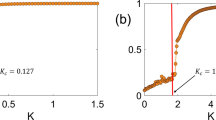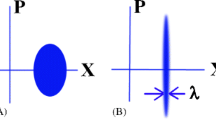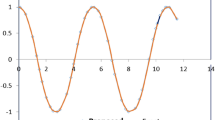Abstract
The single oscillator feedback model describing the circadian system of the nocturnal insect, Hemideina thoracica, (Gander and Lewis, 1979) has been developed and refined by restricting the range of parameter values which successfully simulate the known behaviour of this insect's circadian system. The model accounts for Aschoffs Law for nocturnal animals, and makes new predictions on the combined effects of temperature and constant light on the period of the free-running rhythm, which were verified experimentally. These simulations also indicate that the same general feedback model can be used to describe the circadian systems of other organisms.
Similar content being viewed by others
References
Aschoff, J.: Circadian rhythms: influences of internal and external factors on the period measured in constant conditions. Z. Tierpsychol. 49, 225–249 (1979)
Benson, J.A., Jacklet, J.W.: Circadian rhythm of output from neurones in the eye of Aplysia. IV. A model of the clock: differential, sensitivity to light and low temperature pulses. J. Exp. Biol. 70, 195–211 (1977)
Christensen, N.D., Lewis, R.D.: The circadian locomotor rhythm of Hemideina thoracica (Orthoptera; Stenopelmatidae): the circadian clock as a population of interacting oscillators. Physiol. Entomol. 7, 1–13 (1982)
Christensen, N.D., Lewis, R.D.: The circadian locomotor rhythm of Hemideina thoracica (Orthoptera; Stenopelmatidae): a population of weakly coupled feedback oscillators as a model of the underlying pacemaker. Biol. Cybern. 47, 165–172 (1983)
Cornelius, G., Rensing, L.: Can phase response curves of various treatments of circadian rhythms be explained by effects on protein synthesis and degradation? BioSystems, 15, 35–47 (1982)
Drescher, K., Cornelius, G., Rensing, L.: Phase response curves obtained by perturbing different variables of a 24 hr model oscillator based on translational control. J. Theor. Biol. 94, 345–353 (1982)
Gander, P.H.: The circadian locomotor activity rhythm of Hemideina thoracica (Orthoptera): the effects of temperature perturbations. Int. J. Chronobiol. 6, 243–262 (1979)
Gander, P.H., Lewis, R.D.: The circadian locomotor activity rhythm of Hemideina thoracica (Orthoptera): a feedback model for the underlying clock oscillation. Int. J. Chronobiol. 6, 263–280 (1979)
Johnsson, A., Karlsson H.G.: A feedback model for biological rhythms. 1. Mathematical description and basic properties of the model. J. Theor. Biol. 36 153–174 (1972)
Lewis, R.D.: The circadian rhythm of the weta Hemidenia thoracica (Orthoptera); free-running rhythms, circadian rule and light entrainment. Int. J. Chronobiol. 3, 241–254 (1976)
Njus, D., Sulzman, F.M., Hastings, J.W.: Membrane model for the circadian clock. Nature 248, 116–120 (1974)
Sweeney, Beatrice M.: A physiological model for circadian rhythms derived from the Acetabularia rhythm paradoxes. Int. J. Chronobiol. 2, 25–33 (1974)
Author information
Authors and Affiliations
Rights and permissions
About this article
Cite this article
Christensen, N.D., Lewis, R.D. & Gander, P.H. Properties of a feedback model for the circadian clock of Hemideina thoracica (Orthoptera; Stenopelmatidae). Biol. Cybern. 51, 87–92 (1984). https://doi.org/10.1007/BF00357921
Received:
Issue Date:
DOI: https://doi.org/10.1007/BF00357921




